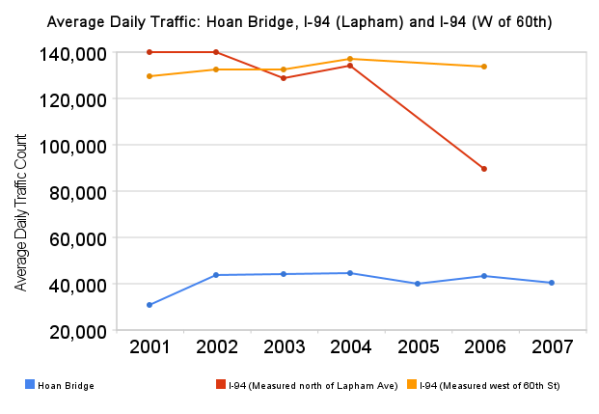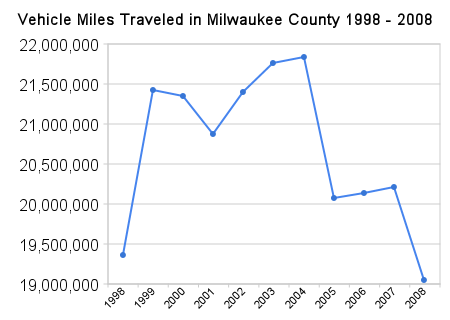It Takes Money To Sometimes Make Money
I’m a little late to this, but here’s the estimated annual investment fees for the Milwaukee County Employee Retirement System. The .25% expense ratio is better than any of us could do with a similar asset allocation.
MKE Connector Comments
I attended the MKE Connector public meeting last Thursday and it was great to see the Mayor and Ald. Bauman there in support.
During the presentation, I learned that the city plans to have a system operating by Spring 2014! Of more immediate concern, is the selection of a locally preferred alternate route by January. Before a decisions is made, the Steering Committee has requested public comments.
It is important to let the planners know how you feel about the three options (#1, #2, #3), with a particular focus on how you would be affected (i.e. how, when and where you would use it).
You can leave your comment at http://www.milwaukeeconnector.com/public_comment.html
Here is the comment I submitted:
I excitedly await deployment of a streetcar connector in Milwaukee. As a young attorney, my quality of life is highly influenced by transit. I live on Kane Place but will be working downtown and often taking advantage of the cultural opportunities available there. Getting in a car to accomplish either is a highly undesirably option. And to be honest, I have considered leaving Milwaukee for a city with better transit options because I feel public transit is the most effective way to build a vibrant city center.
In my opinion, Option #1 is the best selection because it most effectively connects the dense commercial and office concentrations of downtown Milwaukee with the mass of residents who live on the Lower East Side. Beyond the maps of office/retail/residential density that reflect this distribution, I also have noticed that Option #1 follows the route that I and my friends/neighbors take when driving from downtown to the East Side.
Living on Kane Pl., I would gladly walk to Brady St. or even Ogden for a ride downtown. Though the frequency of cars must be in the 7 to 10 min range, or I would probably continue with the 25 minute walk downtown to avoid waiting. Additionally, I hope that the near-term plan includes connecting UWM to the downtown, as that route would connect the dense residential Lower East Side, the student population of the university with the downtown retail and commercial opportunities.
Once this system is up and running, I will consider getting rid of my automobile, which will be feasible as long as I am connected to the job opportunities of downtown and have access to a supermarket.
Traffic Jam
Not sure how accurate these figures are, but Quantcast.com’s rough estimate of Journal Sentinel web traffic over the past 2+ years is quite interesting. Assuming the general trend is true, the layoffs have contributed to a 45% reduction in online visitors. They’re still far ahead in local news web traffic, but that’s a significant drop.
Read The Hoan Bridge & Harbor Redevelopment Study
Courtesy of Sean Ryan at The Daily Reporter here’s the design sketchbook from HNTB on the redevelopment of the Hoan Bridge and the surrounding area.
Notice there’s no mention of removing the downtown/south side connection. In fact, there’s a clear focus on strengthening the bond between the two communities.
What do you think of the study? Is it as threatening as it’s been made out to be by some politicians and supporters of the Hoan?
Time to Share (a bike)

Would a bike sharing program be a boon to MKE’s transit infrastructure?
Recently, D.C. and Boston both unveiled new bike sharing systems. Basically, each city is permitting the installation of bike stands around the city. Program members who pay a regular subscription (or by the hour) can check out a bike from the stand, ride it as they please and return it to one of the bike stands located around the city.
These systems aim to solve two of the main problems of bike riding: attracting people who would prefer to ride, but for whatever reason have left their bike at home, and the bike theft. Both could be alleviated by placing bike rental stands in various parts of the city, allowing people the freedom to spontaneously use a bicycle to get around without the additional ownership and security costs inherent in owning a bike.
Will this work for Milwaukee? It seems likely and definitely worth investigation. For example, I have noticed an anecdotal surge in bike traffic in the city over the last two summers. That, paired with the city’s continuing failure to provide efficient transit options (ahem, light rail), suggests that the noticeable increase in bike traffic is related to pent up transit demand. Thus, a bike share program might be a sufficiently cheap stop-gap transit alternative before a broad-range solution can be implemented.
The Argument To Nowhere
It’s interesting how fast the conversation about the Hoan Bridge devolved into an argument about a non-existent option: tearing down the bridge and not building a replacement. Sounds silly, right?
No one, including the MMAC, is advocating that there be no link between downtown and the south shore communities served by 794, but from all the hyperbolic invective spread by supporters of the Hoan bridge suggesting a grand conspiracy to take away their bridge — a county supervisor among them — you’d be forgiven if that’s the alternative you thought was being studied.
Jeramey Janenne at Urban Milwaukee has already done a wonderful job of explaining one particularly good design alternative, as well as the reason why it’s worth having this discussion.
In short, we’re at a point in the lifespan of the Hoan Bridge where we ought to reexamine whether or not the bridge is being used to its expected capacity. I think it’s clear that it’s not and I believe that it should be replaced with a lower bridge that connects to the lower Third Ward and Bay View in a way that encourages development once the current recession passes.
Here’s a graph comparing the average daily traffic count on the Hoan Bridge (2001-2007), I-94 north of Lapham Avenue (2001-2006) and I-94 west of the 60th Street (2001-2006):

What’s surprising is that even during the development renaissance in Bay View and other south shore communities, the average daily traffic never really increased all that much. Construction on the Marquette Interchange obviously played a role in the traffic decline for I-94, but apparently the Hoan wasn’t an option for south side commuters, thus it didn’t experience any tangible increase in traffic. I believe this would suggest that if a lower bridge was constructed the daily traffic would essentially remain the same as it is now.
More importantly, this graph shows just how underutilized the Hoan truly is. It’s a federal highway that handles less than a third of the traffic of similar highways in the area. In light of this, I would say it’s entirely justified to question why we’re spending hundreds of millions of dollars on a bridge that isn’t serving the greater public in an efficient way. Are we content to spend such a sizable sum on a perpetually underused bridge at a time when we’re also experiencing an overall decrease in vehicle miles traveled in Milwaukee County?

To anyone seriously considering the issue, the answer is a resounding no. We’re not content to waste taxpayer’s money or impede infill development in the city’s core. We’re also not discussing the closing of one of the south shore communities paths to downtown. It’s perfectly fine to argue in support of the Hoan, but let’s refocus the debate toward actual facts and not overheated rhetoric.
All charts were created with data from WisDOT
Great Moments In Milwaukee Advertising
No Age’s Nasty Spill
Friday night was the Milwaukee stop for the No Age/Deerhunter/Dan Deacon Round Robin tour. The momentum-sucking gaps as the bands alternated songs was a little disappointing to me since a straight bill of all three bands could have charged more, sold out a smaller venue AND given fans of each band exactly what they wanted rather than dishing it out in 5-10 minute intervals. Nevertheless, it was a fun time and a creative way to structure the show.
Sadly, the most interesting moment of the night precipitated the abrupt ending of the show (see the 3:00 mark in the video below) — during a dance contest, No Age’s Randy Randall slipped on some Pabst on the floor and dislocated his shoulder. Somehow, he still managed to play Lollapalooza today.
What Is Not But Could Be If

The downtown Milwaukee USPS headquarters along the Menomonee River
Michael Rosen’s piece in Saturday’s Journal Sentinel should be required reading for everyone concerned with the development of UWM’s freshwater research institute on public land along the lakeshore.
I think there are clear positives to locating the institute at the former Pieces of Eight location, but as tempting as it might be to simply forge ahead without considering alternative sites we must begin to make sober assessments of all potential options. The lakefront site appears to be a wonderful choice on aesthetics alone, but what about the land along the Menomonee River currently occupied by the Post Office? What about the Fifth Ward land along Water Street in the inner harbor? Either of these options would provide the opportunity for dramatic redevelopment in the area. The USPS land would appear particularly attractive since the confluence of MMSD, the intermodal transit station and a future freshwater research institute could arguably stand to become the hub of green technology in Milwaukee. And if the USPS land does not become available due to the consolidation of USPS offices, what about the land across the river?
Locating the freshwater research institute on lakefront space would prevent the development from having any continuing catalyst in the area. Since all adjacent land is public space, the building would not spur new development in any significant way. On the other hand, building the institute in either of the two options above would allow for the neighboring land to be redeveloped. That would expand the tax base and provide the city with much-needed additional revenue, not to mention allow companies specializing in green technology to cluster around the institute.
Rather than point to the option we want and ignore other possibilities, we need to consider all potential options and make our decision based on what would provide the most return on our public investment, not the most return for private cheerleaders. In today’s rocky economic climate, that means the efficient leveraging of our public dollar should take precedence over the superficial. Our margin of error is extremely thin these days, so let’s at least study all options available to us before we commit significant taxpayer money to this exciting project.
Guess the Coffee Bar/Sandwich Shop in Bay View…

…that’s for rent/sale.